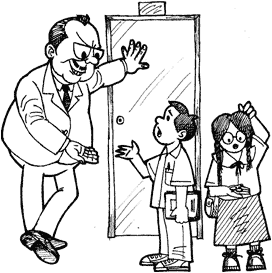The educational system under the Arroyo regime
Gloria Arroyo never made the education of the youth priority during her threeyear term. Instead of having government shoulder the responsibility of improving the educational system, the regime has included the systematic neglect of education in its program. Such neglect is in accordance with IMF and World Bank dictates calling for the regime to turn its back on social services to enable government to allocate its budget for debt payments.
Only P130 billion has been allocated for education in this year's national budget, compared to the P541 billion devoted to service the country's debt. This amount is extremely inadequate to provide for students' needs. Thus, public school students and teachers still suffer from a shortage of facilities, supplies and personnel. No less than the Department of Education has admitted to a lack of 39,383 classrooms, 4,125,413 desks, 9.88 million books and 49,212 teachers when school opened in June. The student-teacher ratio remains at 60:1. A government survey of 400,000 teachers revealed that 55% of schools lack electricity, 84% do not have any water supply, and 38% do not have toilets. Twenty-five percent of the teachers surveyed said that their classrooms did not have ceilings. Due to the teacher shortage, many of them handle subjects they were not trained for. These shortages grow more acute as more and more children reach school age yearly.
As in private schools, tuition fees and other expenses in public colleges and universities have been on the rise. It has become customary not to report these increases to the Commission on Higher Education (CHED). School administrators invoke the fact that government encourages increases in the cost of services that are supposed to be provided for free. Besides, aside from the increase in costs, the government also encourages the commercialization of education through the sale of school property (such as land) and joint ventures with private businesses. One example is a university in Northern Luzon where the comprador-bourgeois Lucio Tan is an administration official.
 The regime does not stand in the way of annual increases in tuition fees and other private school expenses. This school opening, partial reports submitted to CHED indicate that as many as 214 private colleges and universities have already increased tuition fees by 11.39% or P313.24 per unit. The regime does not stand in the way of annual increases in tuition fees and other private school expenses. This school opening, partial reports submitted to CHED indicate that as many as 214 private colleges and universities have already increased tuition fees by 11.39% or P313.24 per unit.
CHED's claim that the 214 represent only 16% of the total number of the country's private colleges and universities is deceptive. The truth is that many schools have not yet reported increases in tuition fees, including those in the Ilocos Region, CAR, Central Luzon, Southern Luzon and Bicol.
CHED also fails to mention that many more schools have increased miscellaneous fees instead of tuition fees. So many schools employ all sorts of trickery to come up with the array of fees to pay. Students receive no explanation about fees that refer to the same items. Some examples are the sports fee, athletic fee and UAAP fee; and the energy fee, power-rate fee and aircon fee. There are other fees that are similarly ludicrous such as the development fee, parking fee, copier fee, and the late enrolment fee, among others.
In many cases, the cumulative amount of all these fees is even bigger than the amount paid for tuition. Schools are not obliged to report these fee increases to CHED.
If children and youth are able to go to school at all, their families are hard-pressed meeting expenses for transportation, pocket money and school supplies. The regime has not yet granted the P125 (now P155) wage increase that workers have been demanding for years and the P3,000 salary increase that government employees have also been clamoring for. Shrinking real wages and salaries, along with the crushing burden of oil price hikes and higher fees for electricity and other needs, further deprive the youth of their right to education.
One reports shows that 1.7 million children between the ages of and 12 are not in school. Out of eight million youth who ought to be in college, only 2.3 million are actually in school. An Ateneo de Manila University study shows that for every 100 students, only 66 will get to finish elementary school, 42 will get to graduate from high school and only 14 will eventually finish college.

| 
